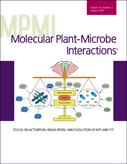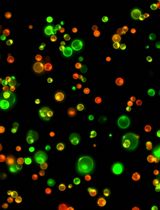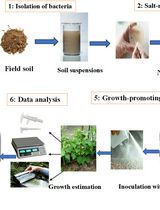- EN - English
- CN - 中文
An Improved Bioassay to Study Arabidopsis Induced Systemic Resistance (ISR) Against Bacterial Pathogens and Insect Pests
一种的可用于检测拟南芥中细菌性病原体和害虫诱导的系统抗性的改进生物学方法
(*contributed equally to this work) 发布: 2019年05月20日第9卷第10期 DOI: 10.21769/BioProtoc.3236 浏览次数: 7909
评审: Zhaohui LiuPalaniappan SivasankarHimanshu Sharma
Abstract
The plant immune system is essential for plants to perceive and defend against bacterial, fungal and insect pests and pathogens. Induced systemic resistance (ISR) is a systemic immune response that occurs upon root colonization by beneficial microbes. A well-studied model for ISR is the association of specific beneficial strains of Pseudomonas spp. with the reference plant Arabidopsis thaliana. Here, we describe a robust, increased throughput, bioassay to study ISR against the bacterial pathogen Pseudomonas cannabina pv. alisalensis (formerly called Pseudomonas syringae pv. maculicola) strain ES4326 and the herbivore Trichoplusia ni by inoculating Pseudomonas simiae strain WCS417 (formerly called Pseudomonas fluorescens WCS417) on Arabidopsis plants grown in Jiffy-7® peat pellets. While most commonly used for Pseudomonas-triggered ISR on Arabidopsis, this assay is effective for diverse rhizosphere bacterial strains, plant species, pathogens and herbivores.
Keywords: Induced Systemic Resistance (ISR) (诱导系统抗性)Background
After plant infection or colonization by pathogenic or commensal microbes, a systemic defense response can ensue involving immunological “memory” or “priming” (Parker, 2009; Fu and Dong, 2013; Martinez-Medina et al., 2016). Depending on the microbe and the associated plant organ, different systemic resistance programs are induced (Pieterse et al., 2014). When roots encounter specific commensal microbes, induced systemic resistance (ISR) in distal root and shoot tissue is observed (Pieterse et al., 1996; van Loon et al., 1998). Although the genetic and hormonal signaling mechanisms deployed during the ISR response are partially understood (Verhagen et al., 2004; Pieterse et al., 2014; Pangesti et al., 2016), many questions still remain unanswered, such as the mechanisms involved in root-microbiome communication or the identity of systemic signal(s) (Pieterse et al., 2014; Haney et al., 2018; Cecchini et al., 2019).
The inoculation of Arabidopsis thaliana roots with Pseudomonas simiae WCS417 has been used as a model system for studying ISR against bacteria, fungi and herbivore invaders (Pieterse et al., 1996; van Loon et al., 1998; Verhagen et al., 2004; Haney et al., 2015). Existing bioassays for P. simiae-Arabidopsis ISR make use of sterile sand-germinated Arabidopsis followed by seedling transplantation into a sand/soil mixture containing the rhizobacteria (Pieterse et al., 1996; Pozo et al., 2008; van Oosten et al., 2008). Building on this method, we have recently developed ISR bioassays against the bacterial pathogen Pseudomonas cannabina pv. alisalensis (formerly called Pseudomonas syringae pv. maculicola) strain ES4326 (Pma) and the herbivore Trichoplusia ni (T. ni) using Arabidopsis plants germinated and grown in Jiffy-7® peat pellets. This is an effective system to robustly trigger and quantify ISR, primarily because peat pellets have a constant volume and low fluorescent pseudomonad content (Haney et al., 2015 and 2018; Cecchini et al., 2019). Moreover, avoiding the transplantation of seedlings reduces the experimental labor and stress to the seedlings, thereby improving assay efficiency. Here, we describe a step-by-step bioassay methodology for ISR experiments that can be potentially standardized across laboratories worldwide.
Materials and Reagents
- 96-multiwell plates (Corning, Costar, catalog number: 2797)
- Kimwipes (Fisher, catalog number: 06-666A)
- 15 ml and 50 ml centrifuge tubes (MidsciTM, catalog numbers: 15 ml-CT2715, 50 ml-CT2750)
- Plastic domes (Hummert International, catalog number: 11-33480) and trays (Hummert International, catalog number: 11-33010)
- 9 cm round Petri dishes (Fisher, catalog number: FB0875712)
- 1.5 ml microfuge tubes (MidsciTM, catalog number: AVSS1700)
- Plastic pestles for 1.5 ml microfuge tubes (Fisher, catalog number: 12-141-364)
- 3 or 5 mm metal beads (QIAGEN, catalog number: 69997 or 69989)
- Trays for holding the Jiffy-7® peat pellets (Hummert International, catalog number: 11311000)
- 1 ml-syringes without needle (BD Biosciences, catalog number: 309659)
- Mesh bags (can be made by sewing a semi-oval out of a fine washable mesh material such as bridal veil; see Figure 3 for schematic; alternatively, perforated cellophane bread bags can be used)
- Tightly closing plastic container (with screwcap lid)
- Damp paper towel
- Fine bristled paint brush
- 96-well racked collection microtubes (optional, for 96-well tissuelyser format) (QIAGEN 19560)
- Arabidopsis thaliana (L. Heyhn.) ecotype Columbia (Col-0)
- Pseudomonas cannabina pv. alisalensis (formerly called P. syringae pv. maculicola ES4326 (Bull et al., 2010) carrying an empty vector (PmaDG3/Pma) (Guttman and Greenberg, 2001) bacterial culture (stored in 15% glycerol at -80 °C)
- Trichoplusia ni (eggs; Benzon Research or Natural Resources Canada)
- Pseudomonas simiae strain WCS417 (formerly called Pseudomonas fluorescens WCS417)
- Jiffy-7® peat pellets (Jiffy products, Canada, Hummert International, catalog number: 14-23700)
- Glycerol (Sigma-Aldrich, catalog number: G7757)
- K2HPO4 (Fisher, catalog number: P288)
- MgSO4 (Fisher, catalog number: BP213)
- Proteose peptone No. 3 (BD Biosciences-US, catalog number: 211693)
- Antibiotics
- Rifampicin (GoldBio, catalog number: R-120)
- Kanamycin (GoldBio, catalog number: K-120)
- Agar (Fisher, catalog number: BP1423)
- Sterile distilled and tap water
- Bleach (Clorox Concentrated Germicidal Bleach)
- Ethanol (Decon Labs Inc., catalog number: 2701)
- Triton X-100 (Fisher, catalog number: BP151)
- Tryptone (BD Biosciences-US, catalog number: 211705)
- Sodium chloride (NaCl)
- Yeast extract (BD Biosciences-US, catalog number: 212750)
- 70% ethanol (see Recipes)
- 25% bleach supplemented with 0.1% Triton X-100 (see Recipes)
- 0.1% agar (see Recipes)
- King's medium B (KB) (see Recipes)
- Luria-Bertani medium (LB) (see Recipes)
- 10 mM MgSO4 (see Recipes)
Equipment
- Laboratory glassware
- 200 µl and 1 ml, and 20-200 µl multichannel micropipettes (Gilson)
- Forceps (Grainger, catalog number: 4CR15)
- 1 L beaker (Pyrex, 1000)
- Handheld electric drill (DeWALT, model: DWD110)
- Cork borer 4 mm diameter
- Autoclave (Primus Sterilizer Co. Inc. 1317. C.R.N: 09415.1256)
- Microcentrifuge (Eppendorf, model: 5415D)
- Freezer (-80 °C) (Panasonic VIP Plus, model: MDF-V76VC-PA)
- Plant Growth chamber at 20-23 °C with 12 h light/12 h dark (~75-100 μmol s-1m-2, cool white fluorescent; A1000 Conviron Growth Chamber with Arabidopsis Kit, or similar. Alternatively, a growth-room with ~135-145 μmol s-1m-2 -mix 50/50 of 400-watt sodium and metal halide bulbs or 75-100 μmol s-1m-2 cool white fluorescent bulbs can be used)
- Shaker incubator at 28 °C (Barnstead Max, model: Q 5000)
- Balance (Mettler Toledo, model: PB1501)
- Spectrophotometer (Bio-Mini SHIMADZU)
- Laminar flow hood (SterilGARD 3 Advance)
- Incubator at 28 °C (VWR, 3020)
- Analytical balance for weighing caterpillars
- TissueLyser Beadmill (QIAGEN, catalog number: 85300) with 24 or 96 adapters (QIAGEN, catalog number: 69982 or 69984)
Procedure
文章信息
版权信息
© 2019 The Authors; exclusive licensee Bio-protocol LLC.
如何引用
Cecchini, N. M., Song, Y., Roychoudhry, S., Greenberg, J. T. and Haney, C. H. (2019). An Improved Bioassay to Study Arabidopsis Induced Systemic Resistance (ISR) Against Bacterial Pathogens and Insect Pests. Bio-protocol 9(10): e3236. DOI: 10.21769/BioProtoc.3236.
分类
植物科学 > 植物免疫 > 宿主-细菌相互作用
微生物学 > 微生物-宿主相互作用 > 细菌
生物化学 > 其它化合物 > 抗菌剂
您对这篇实验方法有问题吗?
在此处发布您的问题,我们将邀请本文作者来回答。同时,我们会将您的问题发布到Bio-protocol Exchange,以便寻求社区成员的帮助。
Share
Bluesky
X
Copy link














